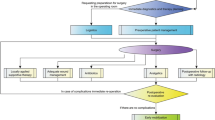Abstract
Purpose
To assess the trends in Le Fort (maxillary) fractures in patients seen at a South American trauma care center based on the characteristics and management of these.
Materials and Methods
Of all patients with facial fractures seen at a trauma hospital during a six-year period, 50 (6.6 %) presented with Le Fort fractures. Medical charts were reviewed for characteristics presented and management performed. To improve the analyses, computed tomography and intraoperative findings were used. Statistical analyses involved descriptive statistics and the likelihood ratio test.
Results
The fractures were Le Fort II (52 %), Le Fort I (22 %), Le Fort type-associated (20 %) and Le Fort III (6 %). Male patients (90 %) in their third decade of life (38 %) were more frequent (p = 0.022). Traffic accidents (56 %) were the major etiologic factor (p = 0.048). There were 1.4 additional facial fractures per patient, with predominance of zygoma fractures (36.5 %). Most of the cases were managed by open reduction (60 %) (p = 0.015) with the subciliary approach (42.7 %) (p = 0.001). The 1.5-mm system was the most used fixation and the zygomaticomaxillary suture the most frequent location (p = 0.001).
Conclusion
the most common patient with a Le Fort fracture is an adult male, with a Le Fort II fracture due to a traffic accident requiring surgical fixation on zygomaticomaxillary suture.



Similar content being viewed by others
References
Stanley RB Jr, Funk GF (1988) Rigid internal fixation for fractures involving tooth-bearing maxillary segments. Arch Otolaryngol Head Neck Surg 114:1295–1299
Frakes MA, Evans T (2004) Evaluation and management of the patient with LeFort facial fractures. J Trauma Nurs 11:95–101
Marciani RD (1993) Management of midface fractures: fifty years later. J Oral Maxillofac Surg 51:960–968
Kahnberg KE, Gothberg KA (1987) Le Fort fractures (I). A study of frequency, etiology and treatment. Int J Oral Maxillofac Surg 16:154–159
Bagheri SC, Holmgren E, Kademani D, Hommer L, Bell RB, Potter BE et al (2005) Comparison of the severity of bilateral Le Fort injuries in isolated midface trauma. J Oral Maxillofac Surg 63:1123–1129
Fraioli RE, Branstetter BF, Deleyiannis FWD (2008) Facial fractures: beyond Le Fort. Otolaryngol Clin N Am 41:51–76
Marciani RD, Gonty AA (1993) Principles of management of complex craniofacial trauma. J Oral Maxillofac Surg 51:535–542
Hogg NJV, Stewart TC, Armstrong JEA, Girotti MJ (2000) Epidemiology of maxillofacial injuries at trauma hospitals in Ontario, Canada, between 1992 and 1997. J Trauma 49:425–432
Gassner R, Tuli T, Hachl O, Rudisch A, Ulmer H (2003) Cranio-maxillofacial trauma: a 10 year review of 9,543 cases with 21,067 injuries. J Craniomaxillofac Surg 31:51–61
Mohajerani SH, Asghari S (2011) Pattern of mid-facial fractures in Tehran, Iran. Dent Traumatol 27:131–134
Rhea JT, Novelline RA (2005) How to simplify the CT diagnosis of Le Fort fractures. AJR Am J Roentgenol 184:1700–1705
Chen WJ, Yang YJ, Fang YM, Xu FH, Zhang L, Cao GQ (2006) Identification and classification in Le Fort type fractures by using 2D and 3D computed tomography. Chin J Traumatol 9:59–64
Sherer M, Sullivan WG, Smith DJ Jr, Phillips LG, Robson MC (1989) An analysis of 1,423 facial fractures in 788 patients at an urban trauma center. J Trauma 29:388–390
Motamedi MHK (2003) An assessment of maxillofacial fractures: a 5-year study of 237 patients. J Oral Maxillofac Surg 61:61–64
Campolongo GD, Barros T, Sevilha FM, Oliveira RJ, Luz JGC (2012) Electromyographic study in patients with surgically treated facial fractures. J Craniofac Surg 23:1329–1332
Chrcanovic BR, Freire-Maia B, Souza LN, Araújo VO, Abreu MHNG (2004) Facial fractures: a 1-year retrospective study in a hospital in Belo Horizonte. Braz Oral Res 18:322–328
Bellamy JL, Mundinger GS, Reddy SK, Flores JM, Rodriguez ED, Dorafshar AH (2013) Le Fort II fractures are associated with death: a comparison of simple and complex midface fractures. J Oral Maxillofac Surg 71:1556–1562
Gandhi S, Ranganathan LK, Solanki M, Mathew GC, Singh I, Bither S (2011) Pattern of maxillofacial fractures at a tertiary hospital in northern India: a 4-year retrospective study of 718 patients. Dent Traumatol 27:257–262
Crivello O Jr, Luz JGC, Lemos JBD, Rezende JRV (1989) Considérations statisques sur lês fractures isolées maxilo-faciales à Sao Paulo. Rev Stomatol Chir Maxillofac 90:100–103
Torgersen S, Tornes K (1992) Maxillofacial fractures in a Norwegian district. Int J Oral Maxillofac Surg 21:335–338
Romano JJ, Manson PN, Mirvis SE, Dunham M, Crawley W (1990) Le Fort fractures without mobility. Plast Reconstr Surg 85:355–362
Crawley WA, Azman P, Clark N, Robertson B, Slezak S, Vander Kolk C et al (1997) The edentulous Le Fort fracture. J Craniofac Surg 8:298–307
McRae M, Frodel J (2000) Midface fractures. Facial Plast Surg 16:107–113
Wang H, Chen MS, Fan YB, Tang W, Tian WD (2007) Biomechanical evaluation of Le Fort I maxillary fracture plating techniques. J Oral Maxillofac Surg 65:1109–1116
Conflicts of interest
None
Ethical standard
Approved by the local human research ethics committee.
Author information
Authors and Affiliations
Corresponding author
Rights and permissions
About this article
Cite this article
Oliveira-Campos, G.H., Lauriti, L., Yamamoto, M.K. et al. Trends in Le Fort Fractures at a South American Trauma Care Center: Characteristics and Management. J. Maxillofac. Oral Surg. 15, 32–37 (2016). https://doi.org/10.1007/s12663-015-0808-z
Received:
Accepted:
Published:
Issue Date:
DOI: https://doi.org/10.1007/s12663-015-0808-z




